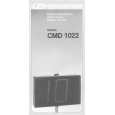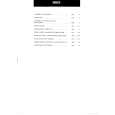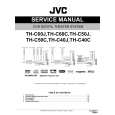|
|
|
Productos
|
|
Información
|
|
Destacado
|
|
|
 |
|
|
No hay comentarios de productos.
3-5
SERVICE TEST PROGRAM
1. PRELIMINARY SETUP � To enter the service test program disconnect the AC/DC adaptor and remove batteries, open the CD-door and hold the buttons �PLAY� & �PREV� depressed while turning power on (i.e. connecting the AC/DC adaptor). � The display shows the software version of the built-in µP (i.e. � S-26�). Versions are counted from � 00� onwards; that means the higher the number the newer the software. � The program is now in the main menu � various tests can be entered by pressing the corresponding buttons (see flow chart on next page or detailed description of available tests below). � To exit the service test program press the �STOP� button or disconnect the set from the power source. 2. DISPLAY TEST Purpose: Check functionality of display and display driver. � To enter the display test start the service test program and press the �NEXT� button. � The display shows test pattern1. All segments are activated for finding open circuits (see flow chart on next page). � To jump to the next pattern press the �NEXT� button. � The display shows test pattern2. All alternate pins (2, 4, ...) are activated for finding short circuits (see flow chart on next page). � To jump back to test pattern1 press the �NEXT� button, to exit the display test and return to the main menu press the �STOP� button. 3. KEY TEST Purpose: Check operation of keys and cord remote control. � To enter the key test start the service test program and press the �MODE� button. � The display shows �--�. � Hold key depressed and check corresponding key code on the display. Key codes can be found in table1 (see flow chart on next page). � To exit the key test and return to the main menu press the �STOP� button. 4. PLAYBACK TEST WITH ERROR ANALYSIS Purpose: Analyze errors that occur during playback and search for intermittent failures. � To enter the playback test start the service test program and press the �BASS� button. � To start the error analysis press the �PLAY� button. Note that the playback test can only be entered if the CD-door is closed. � The set will read the TOC and start playback. As long as the playback is free of errors the display shows track and time information like in normal play-mode. In case of errors corresponding error codes will be displayed. The meaning of these error codes can be found in table2 (see flow chart on next page). Note: Errors can either be �fatal� or �non fatal�. Fatal errors always stop the playback, non fatal errors only cause a short interruption of the music. Fatal errors are displayed as long as the set is connected to the power source, non fatal errors are displayed until a new error occurs or a button is pressed. � To stop the playback test disconnect the set from the power source. 5. SERVO TEST Purpose: Check door switch, inner switch of CD-drive, movement of slide and acceleration of discmotor. � To enter the servo test start the service test program and press the �PLAY� button. � The display shows �Cd xy�. �x� indicates state of door switch; �y� indicates state of inner switch. x,y = �0� means switch is closed; � 1� means switch is open. � To move slide outside hold the �NEXT� button depressed. � To move slide inside hold the �PREV� button depressed. � To accelerate the discmotor clockwise hold the �MODE� button depressed. � To accelerate the discmotor counter-clockwise hold the �PROG� button depressed. � To enter the focus test press the �PLAY� button, to exit the servo test and return to the main menu press the �STOP� button. 6. FOCUS TEST Purpose: Check movement of lens and operation of focus servo for CDDA and CDRW discs.
Since the CDRW reflects much less light than an ordinary CDDA, the gain of the HF-amplifier stage and the sensitivity of the ADC inside the Decoder&Digital Servo IC �CD10� must be adapted accordingly. The gain is switched via the CDRW input of the HF-preamplifier. The ADC-sensitivity is set via software parameters (sent from µP to �CD10�). In total, there are 4 sensitivity modes available: 1 for CDDA and 3 for CDRW. The modes are listed in table3 (see next page). In normal play-mode, the correct focus sensitivity is choosen automatically during start-up (see �Start-up procedure� on previous page). In the service test program, the sensitivity can be choosen manually in order to allow individual measurements in several modes.
� The focus servo loop is switched on and the set starts searching the focus (�focus ramping�). As soon as the focus has been found the focus servo loop is closed and the state of the focus is monitored continuously. � If the focus is OK the display shows � F x�, else �-F x�. �x� indicates the sensitivity mode. Details can be found in table3 (see flow chart on next page). � To toggle between sensitivity modes press the �BASS� button. � To move slide outside hold the �NEXT� button depressed. � To move slide inside hold the �PREV� button depressed. � To accelerate the discmotor clockwise hold the �MODE� button depressed. � To accelerate the discmotor counter-clockwise hold the �PROG� button depressed. � In case the focus is OK the discmotor test can be entered by pressing the �PLAY� button, to exit the focus test and return to the main menu press the �STOP� button. 7. DISCMOTOR TEST Purpose: Check speed regulation of discmotor. � The speed regulation is switched on and the discmotor starts rotating. If the speed reaches 75% of the nom. speed the display shows � d�, else �-d�. � In parallel also the state of the focus is monitored continuously (display � F x� or �-F x�). � In case the disc speed is OK and the focus is OK the radial test can be entered by pressing the �PLAY� button, to exit the discmotor test and return to the main menu press the �STOP� button. 8. RADIAL TEST Purpose: Check if radial loop locks and an audio signal is audible at the headphone output. � The radial servo loop is switched on, mute is released and the audio signal is audible. If the system is on track the display shows � r�, else �-r�. � In parallel also the disc speed (display � d� or �-d�) and the state of the focus (display � F x� or �-F x�) are monitored continuously. Note: In case of radial errors the audio output is muted and muting is not released automatically when the systems recovers from the error. � -r� remains on the display. To open mute again press the �NEXT� or �PREV� button. � To jump 16 tracks outside press the �NEXT� button. � To jump 16 tracks inside press the �PREV� button. � To exit the radial test and return to the main menu press the �STOP� button, to exit the service test program disconnect the set from the power source. Important remark: In radial test mode data to the DRAM is written at 1.2 times the nominal speed, and read from the DRAM at nominal speed. Because writing is done faster than reading the DRAM gets full after a certain time. In normal play mode the system would now wait until the DRAM is partly emptied again, jump backwards and resume filling at the last written position. However, in radial test mode the jumps would disturb measurements on the radial servo loop. Therefore this function has been disabled and filling restarts immediately from the current position of the pick-up unit. As a result �jumps� are audible during playback.
|
|
 |
> |
|





